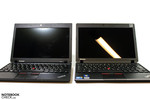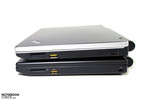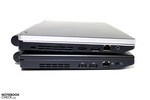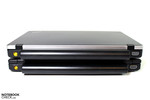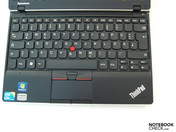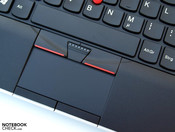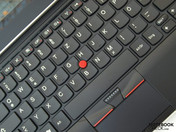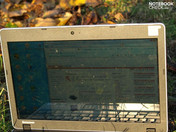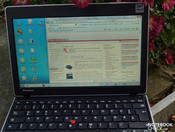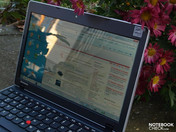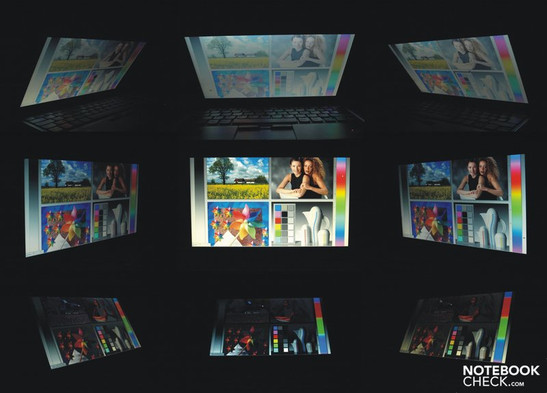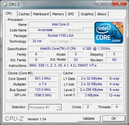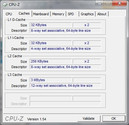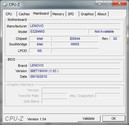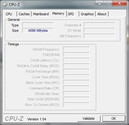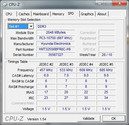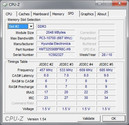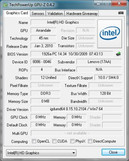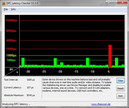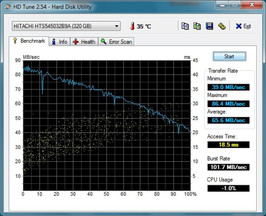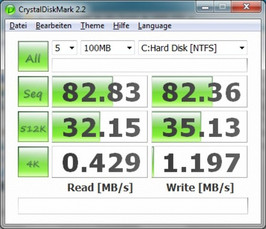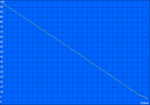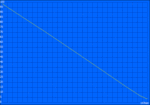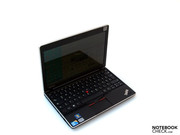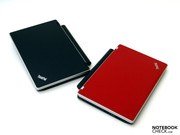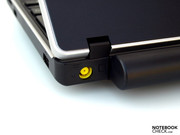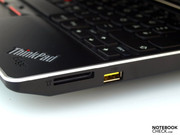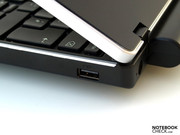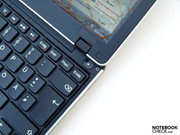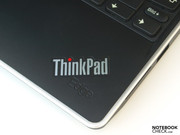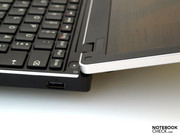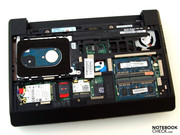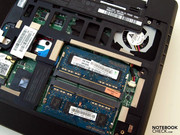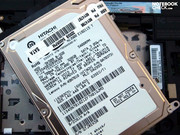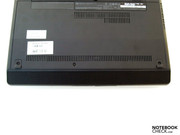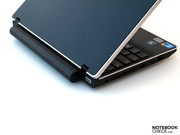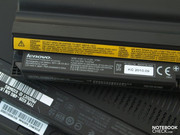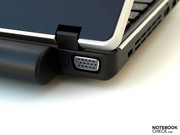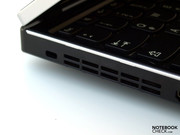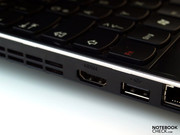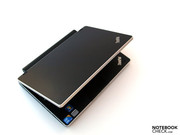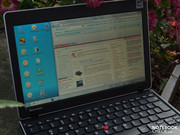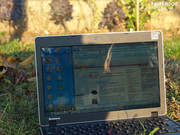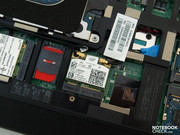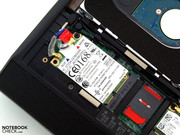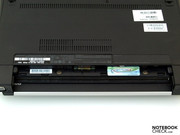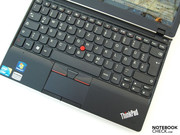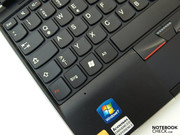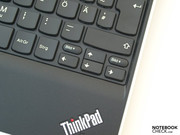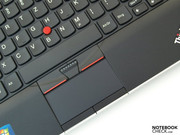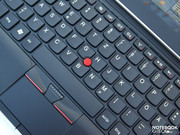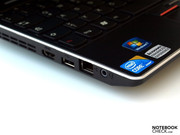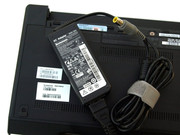Review Lenovo ThinkPad Edge 11 Notebook
So it’s a reasonably priced business device? According to Lenovo, the Thinkpad Edge series offers “innovative, straight-forward, reliable and affordable” models in various sizes and equipment configurations.
We are taking a detailed look at the smallest member of the family, namely the Thinkpad Edge 11, and want to find out how and to what extent it differs from the previously reviewed Thinkpad X100e, which is visually almost identically constructed. We reviewed an Edge 11 with Intel equipment, namely a Core i3 380UM CPU, GMA HD Graphics chip, four gigabytes of RAM and a conventional harddrive.
Lenovo also offers models with an AMD CPU as an alternative. We will soon look closer at one of these in a comparison test. Sections dealing with performance-bearing components are not necessarily applicable to other models.
Case
Externally, the Edge 11 reminds us a great deal of the X100e. Although the later was still completely black, the chrome-colored edging on the Edge 11 serves to loosen up the optics. What’s new is that the I-point of the two ThinkPad logos was moulded with a small red LED which lights up during operation. Those who nevertheless find the black version too depressing can also get a model with a display lid painted in gloss-red – together with all the drawbacks, smudges and scratches that go along with that.
In spite of the plastic case, one can be very satisfied with the pressure stability and torsional stiffness of the base unit and display. Only the display frame gives somewhat under pressure. The battery sits firmly in the case, however when removed it leaves a recess above the keyboard.
Though the small hinges are relatively stiff, they can’t totally prevent teetering after the opening angle has been adjusted. The display also vibrates somewhat when working in unstable environments, such as on a train. Though it is possible to close it with one hand, opening or increasing the opening angle requires both hands due to the light weight of the base unit. Since Lenovo did without a transport lock, and as the hinges don’t have enough tension force to keep the laptop completely closed with the base unit, one has to make sure that no bits of foreign matter slip in between the keyboard and display during transport.
Compared to the X100e, the case of the Edge 11 now receives a thin grip on the chrome-coloured display frame for easier opening of the notebook. A word of caution to all those who are still tempted to grab for the upper edge of the display when opening the laptop: Both touchpad keys close up flush with the display lid and base unit. As the gap between the touchpad buttons and the base unit is larger than that between the display lid and base unit, attempting this could result in the display being pulled up together with the touchpad buttons. So caution is advised!
Connectivity
One wouldn’t expect such abundant interface equipment just based on the form factor alone. Even so, the Edge 11 offers 3 USB-2.0 ports in all, one of which is executed as a “powered USB”, thereby allowing it to load small devices from the laptop when turned off. Especially appealing: In addition to a VGA port for analogue connections of an external monitor or beamer, there is also an HDMI interface. Further we discovered a combined audio port for connection a headset and a 4-in-1 card reader (SD/MMC/MS/MS Pro).
Depending on how occupied it is, left-handers unfortunately won’t be too pleased with the interface layout. Conveniently, at least the VGA is found in the rear. Missing is the docking port typically found on business machines. However, Lenovo does offer a USB port replicator as an additional at-cost accessory for the ThinkPad.
Communication
Wired Ethernet connections can be made with help of the Realtek RTL8168D/8111D Family PCI-E GBE NIC (10/100/1000Mbps). The built-in Intel WiFi Link 1000 BGN (bgn) module supports Standard-n and therefore allows for fast connection via WiFi-Hotspot if given the appropriate infrastructure. At hand is also a Qualcomm Gobi 2000 HS- USB modem 9205 for mobile broadband connections. The corresponding SIM slot isn’t located in the battery compartment as is usual, but rather below the service access panel.
A webcam is found in the upper display frame, meaning that the user is well-equipped for video conferencing, etc. Lenovo also kept Bluetooth in mind for communication with small mobile devices such as a PDA or mobile phone.
Security
Although the 11.6-incher from Lenovo is classified as a business device, it doesn’t offer any special security features, indeed probably due its size. A commonly found Kensington security slot is the only thing on board.
Accessories
As is typical with Lenovo, only the necessary accessories are delivered, i.e. battery, power adapter, cable and some printed information. The user has to themselves take care of setting up data recovery medium via the ThinkVantage Tools.
One can choose from quite a few optional accessories at an extra cost: bag, external mouse and keyboard, harddrive, a universal power pack with various adaptors, a port replicator and a so-called Power hub which can be used for loading the notebook’s battery, connecting up to four USB devices and loading devices via USB.
Guarantee
Their ex-works guarantee is 12 months.
Input Devices
The input devices are on the whole the same as those on the Thinkpad X100e.
Keyboard
The Chiclet-keyboard, in other words a design with individual keys, has a standard layout apart from the swapped Ctrl and Fn keys typical of Lenovo. Thus the user quickly feels at home and easily gets going in the touch-typing system. Again pleasing are the, for laptop size standards, relatively large keys measuring around 15 millimetres wide and 14 millimetres deep. Their front edge facing the user were rounded and they have a relatively generous spacing of 3 millimetres.
Also pleasing are the mechanical characteristics, balanced stroke and clear feedback. They have a pleasantly quiet stop sound even during energetic typing.
Substitute Mouse
As is typical for the Thinkpad, it again comes with two mouse sets. One is a thin touchpad measuring around 75 millimetres in width and 34 millimetres in depth, which lies clearly deeper than the surrounding case housing. The non-rounded edge is raised up around 2 millimetres out back and thus clearly separates the touchpad from the case.
The touchpad surface has a pleasant satiny feel and offers good gliding characteristics. Precision and response are outstanding. In addition to the vertical and horizontal scrolling area, the touchpad also supports mutli-touch movements, for instance pinch-zoom, rotation and pivoting.
The corresponding buttons are relevantly thin and end flush at the front edge of the case. They are evenly responsive across their entire surface and offer a relatively long stroke. They also work relatively quietly.
Also on board is of course the red trackpoint between G, H and B. As usual, it works flawlessly and after just a short settling time, the mouse cursor can be controlled precisely and effortlessly. The corresponding keys were designed as flip switches, yet they respond evenly across their entire expanse. If the centre key is held down, one can scroll through a document by moving the trackpoint.
Display
Here is where the first difference from X100e becomes apparent. The 11.6” (26 cm x 14 cm) display with a maximum resolution of 1366x768 pixels, in other words a 16:9 format, has a reflective surface. More specifically it is an LGD02BE from LG Display.
The resolution is very fine for an 11-incher, which means that fonts appear very small. This can be resolved temporarily with a screen magnifier or permanently with a larger font display.
| |||||||||||||||||||||||||
Brightness Distribution: 79 %
Contrast: 142:1 (Black: 1.16 cd/m²)
Though the display, with a maximum 204 cd/m² and approximately 182 cd/m², is on average a bit dimmer than that of the X100e, it is a bit more evenly illuminated with a brightness distribution of 79%, which is just barely good enough. With a slightly lower level of black of 1.16 cd/m² and the lower brightness level, the two displays are about on the same level in terms of contrast (142:1).
Subjectively, the colour representation is decent and the picture sharp. We also couldn’t discern any obvious shading.
Why Lenovo delivers a business-laptop with a glossy display surface remains a mystery. Though the size indicates in any event that the device was not developed for continuous use at workstations, annoying reflections are apparent even indoors under unfavourable lighting conditions. This effect is enhanced when used outdoors, especially under direct sunlight. Thus there are certainly better suited candidates when looking for a mobile travel companion.
Like on the X100e, the viewing angle stability is typical for a notebook. Horizontally, one is pleased by a generous working space, while vertically, image distortions quickly appear in the form of overexposure when viewed from above or darkening when viewed from below.
Performance
The Edge 11 as it is equipped here is based on the Intel HM55 chipset and uses an Intel Core i3 380UM processor, in other words a dual-core, ultra-low-voltage processor for very small and light notebooks which clocks at 1.3 GHz. Thanks to Hyperthreading, it can operate up to four threads at once. Turbo-Boost supports only the graphic chip, but not the CPU itself. There is also no support for the AES encryption commands, the VT-d functions or Trusted Execution.
The processor has a total of four gigabytes of memory at its disposal in the form of two two-gigabyte DDR3 modules (PC-10700). In contrast to a 32-Bit operating system, the pre-installed Windows 7 Processer 64-Bit also allows these to be utilized efficiently. An easily accessible service flap on the underside of the device allows for convenient access to the main memory and other components.
A Graphics Media Accelerator HD integrated into the processor is used for video output. This has its greatest advantage in terms of current consumption. In terms of performance the device is designed for non-demanding Office and Internet tasks, while the 3D performance just barely enough for undemanding games.
| PCMark Vantage Result | 3619 points | |
Help | ||
Anyway, Atom notebooks are clearly outdone in the CPU-oriented benchmarks. It even wins hands down over the Athlon Neo MV-40 in the X100e, for example by 72% in the SuperPi32M (1796 vs. 3090 seconds). This is also confirmed by the computer-arithmetic benchmarks from SiSoft Sandra. The CPU achieved 19519 MIPS and 13800 MFLOPS, while the X100e only got 5800 MIPS in the Dhrystone and 4908 MFLOPS in the Whetstone benchmarks.
The MV-40 in the X100e is a single-core processor. It was clear in the Cinebench R10 that the Edge 11 performs somewhat better in the Single Rendering Test with 1495 points than the X100e (1274 points). The Edge is good for 3499 points in the Multi-Rendering Test.
Thus the Core i3 380UM is overall on the same level as for instance the old-proven Core 2 Duo SL9400, the SU9400, and the Core 2 Duo T4300.
Let’s now turn to the application performance. The PCMarkVantage Test deals with the overall performance of the system and evaluates the interplay of the components. The graphics performance plays only a minor role in this. The Intel Version of the Edge 11 tested here got an overall score of 3619 points. It therefore clearly surpasses the X100e (Athlon Neo MV-40, HD3200, 1387 pts.) by 161%. In terms of application performance, it can for instance match subnotebooks like the Toshiba Satellite U500-115 (P8700, Mobility Radeon HD 4570 pts.3632.0) or even surpass for instance the Apple MacBook Air 2009-06 2.1 (SL9600, GeForce 9400M pts. 3487.0). Laptops with Core i3 CPU perform even better. Still, the application performance is easily enough to handle the normal working day.
In the graphics-intense benchmarks, the GMA HD Graphics chip gets up to a an expected level with 1131 points in the 3DMark06, 2204 points in the 3DMark05 and 1282 points in the Cinebench R10 Shading Test. The Edge 11 definitely performs better than the X100e up to the 3DMark03. Only in the 3DMark01 is the order just barely, but in indeed reversed.
| 3DMark 2001SE Standard | 5537 points | |
| 3DMark 03 Standard | 3159 points | |
| 3DMark 05 Standard | 2204 points | |
| 3DMark 06 Standard Score | 1131 points | |
| 3DMark Vantage P Result | 119 points | |
Help | ||
A Hitachi HTS545032B9A300 harddrive was built in as the mass media. It has 320GB of gross capacity and works with a rotational speed of 5400 rpm. The values gotten with the HDTune are as expected.
The user has to make do without a built-in optical drive. As neither eSATA nor USB-3.0 are available, nor an ExpressCard slot for corresponding expansions, an external drive can only be connected via USB-2.0.
Game Verdict
The GMA HD graphics chip is a widely-used graphics solution for which there’s already a range of test data in our database. We therefore chose to forgo any comprehensive gaming tests
The 3D-performance is not particularly high and modern 3D-heavy computer games are at best possible with low detail settings. However, that’s not what the mini-laptop was designed for. For further information about graphics performance, please refer to our game list and our benchmark list of mobile graphic cards.
Emissions
System Noise
Under low load, our tester remained pleasantly quiet and reached a maximum volume of 33.8 dB(A). As long as the demands were not raised too much, the noise remains on this level. Only in a stresstest could we measure up to 36.5 dB(A). Even then one only notices a relatively low-frequency buzz. Yet compared to the X100e, the Edge 11 can get much louder.
Noise Level
| Idle |
| 32.6 / 33.8 / 33.8 dB(A) |
| Load |
| 33.8 / 36.5 dB(A) |
 | ||
30 dB silent 40 dB(A) audible 50 dB(A) loud |
||
min: | ||
Temperature
On the other hand, Lenovo has the heat development under control in the Edge 11. Even during the stresstest the temperature did not exceed body temperature at any spot. Furthermore, the palm rests and touchpad remain pleasantly cool. The core temperatures stay at around 70 degrees Celsius.
(+) The maximum temperature on the upper side is 36.1 °C / 97 F, compared to the average of 35.9 °C / 97 F, ranging from 21.4 to 59 °C for the class Subnotebook.
(+) The bottom heats up to a maximum of 35.3 °C / 96 F, compared to the average of 39.3 °C / 103 F
(+) In idle usage, the average temperature for the upper side is 29.7 °C / 85 F, compared to the device average of 30.8 °C / 87 F.
(+) The palmrests and touchpad are cooler than skin temperature with a maximum of 29.8 °C / 85.6 F and are therefore cool to the touch.
(±) The average temperature of the palmrest area of similar devices was 28.2 °C / 82.8 F (-1.6 °C / -2.8 F).
Speakers
Nothing has changed here from the X100e either in terms of the position or quality. To sum up, one can conclude that though the sound is lacking in bass, it is surprisingly good for such a mini-notebook. Still, the Edge 11’s speakers found on the slanted front edge can’t compete with an external sound system.
More volume and bass can be had by connecting high-quality headphones through the 3.5 mm combined audio jacks. Testing of this went along without any abnormalities.
Battery Life
The Thinkpad Edge 11 is delivered with the same battery as on the X100e. This is found in the rear upper area and offers a capacity of 57 watt-hours (10.8V, 5.2 Ah). Due to the somewhat low performance potential of the Edge 11, one can generally expect better battery runtimes.
Even when the components are put under heavy load, as is simulated for us with the BatteryEater Classic Test with maximum display brightness, high-performance profile and wireless modules turned on, the Edge 11 still holds up almost two and a half hours on battery power, which is a good half hour longer than the X100e.
Surprisingly, under low load, such as when reading a text with minimum brightness, energy-savings profile and consumers turned off, the results are just barely, though indeed reversed as the Edge is outdone by around fifteen minutes. The Battery Eater Reader’s Test showed us a bit more than five hours.
In practice, one can research in WLAN-mode around four and a quarter hours. The tester is therefore slightly better than the X100e (4:35 h).
In terms of current consumption, there is an improvement over the X100e in almost all areas relating to the hardware equipment. Plus points include the low values in standby and when turned off. The power adapter is sufficiently dimensioned with 65 watts and therefore doesn’t get too warm.
| Off / Standby | |
| Idle | |
| Load |
|
Key:
min: | |
Verdict
Whether the Lenovo Thinkpad Edge 11 with its non-anti-glare display is really the ideal travel companion for business purposes is doubtful. A matte display should actually be obligatory for a pro-machine.
The notebook certainly scores with its ample communication equipment which also includes a broadband modem. The battery runtime is entirely suitable for mobile work even if a full working day away from an outlet isn’t possible. Compared to the Thinkpad X100e, the Edge 11 wins above all in terms of application performance, though the two can be described as pretty much even in terms of battery runtimes.
As is the case on most mini-laptops, one still has to make do without an integrated optical drive. Though Lenovo also saved on the docking port, really a must-have for business machines, one can fall back on a USB-docking solution. At least the VGA port is found at the rear. But depending on occupation, left-handers won’t be too pleased about the LAN and HDMI port being in the mid to front area on the left side.
The compact 11-incher is suited for mobile communication, Internet and Office. In terms of performance, it has some advantage over current netbooks and thereby justifies the higher price.




